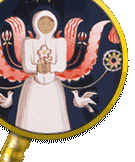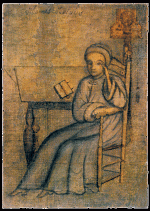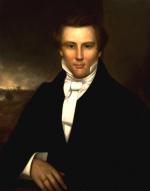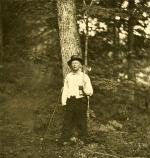Chapter Two: Three Centuries of Utopian Communities in Pennsylvania
And the multitude of those that believed were of one heart and one soul; neither said any of them that any of the things which he possessed was his own; but they had all things common.
Acts 4: 32-35
When William Penn in the 1680s opened his lands in North America as a haven for his fellow Quakers, he also offered it as a refuge to other Europeans who suffered persecution for their religious beliefs. Pennsylvania quickly became a multinational and multi-religious colony unlike any other in North America. Rich with natural resources and economic opportunities, it attracted English Anglicans, French Huguenots, Scottish and Scots-Irish Presbyterians, Irish Catholics, and Sephardic Jews.
For most of the eighteenth century, Pennsylvania was one of the few areas under British control where Catholics could legally worship. Penn's promise of religious toleration proved especially attractive to Protestant sectarians in Germany, more than 5,000 of whom left their homes to settle in Pennsylvania during the eighteenth century.
Among the religious refugees who immigrated to Pennsylvania were small groups of radical German-speaking Protestants who were determined to live apart from others. These religious communitarians believed that they constituted a separate and consecrated body that must live apart from the sinfulness of the world. Many wanted to recreate the simple lives and pure faith of the early Christians and to create autonomous states as independent as possible from outside civil or religious authority. The desire to distance themselves from the corruption of the world also had motivated the Pilgrims in their migration to Plymouth in 1620 and the great Puritan exodus to the Massachusetts Bay Colony in the 1630s. The English separatists who settled in New England, however, were no friends of religious pluralism.
The 1730s witnessed the appearance in Pennsylvania of two pietist groups that would become deeply identified with Pennsylvania: the "Solitaries" and "Householders" of the Ephrata Cloister, a non-utopian sect, and the Amish. Founded in 1732 by Conrad Beissel, a German pietist who more than a decade before came to Pennsylvania to join
Emphasizing spiritual rather than material goals, the Brothers and Sisters of the Ephrata Cloister made important contributions to colonial life and culture. They ran an important printing operation and produced exquisite, hand-illuminated books and documents in the style known as Fraktur. The choir performed its renowned hymnal music in a hauntingly beautiful style designed to move listeners and singers alike to a state of mystical exaltation. In the late 1700s, an "offspring" of Ephrata formed at the base of the South Mountains in Pennsylvania's Franklin County. Although it bore little physical resemblance to the Cloister of Ephrata, the
In 1736, a small group of Swiss Brethren known as the Amish, or followers of Jakob Ammann, established their first significant New World settlement at
The Amish, like the Quakers, Mennonites, Moravians, and Beissel's followers at Ephrata, were pacifists. Following Christ's self-sacrificial model and his Sermon on the Mount, their churches taught them to be willing to die, but not to kill for their beliefs. Maintaining their "non-association" with the local militias and their detachment from political affairs, however, proved problematic, especially during the French and Indian War and the American Revolution when their refusal to bear arms and attempts to remain politically neutral drew the anger of their neighbors and Pennsylvania's political and military leaders.
During the American Revolution, the peace churches struggled to maintain their distance from the outside world, even as the events of the war intruded on their communities. After disastrous defeats at Brandywine Creek and Germantown, the American army carted wounded soldiers to Ephrata, Bethlehem, Nazareth, and Lititz, where they commandeered buildings and the pacifist pietists into service.
Once free from Britain, Americans joined together in a nation that guaranteed a broad range of inalienable rights to its citizens, including the free practice of religion. But the new Republic was also plagued by race slavery, violence, greed, and other human imperfections. So the search for religious communitarian solutions to the problems of the human condition continued. Indeed, the American experiment in representative self-government made the United States the ideal site for new communitarian experiments that would be based on social contracts fashioned by reason as well as those based on religious faith.
In the early nineteenth century, tens of thousands of Americans were swept up in religious revivals so widespread they became known as the Second Great Awakening. From the "Burned Over District" of western New York to the canebrakes of Kentucky, Americans followed new prophets and embraced new faiths, including the Church of Jesus Christ of Latter-day Saints, whose founder
In the 1830s and early 1840s, thousands embraced the vision of millennialist preacher William Miller, who prophesized the Second Coming of Christ would occur in March 1843. In 1850 former Millerite Peter Armstrong led a small group of followers to the Endless Mountains of Pennsylvania to found the community of
Secular efforts to accelerate human progress in the world through communitarian principles also arose during the early 1800s. Among the most significant was that promoted by English industrialist Robert Owen, who in 1824 bought the Harmonists' abandoned community in Indiana and attempted to build a socialist utopia that would serve as a model for the world. Owen's "New Harmony" experiment quickly failed, but the dream lived on as social theorists and reformers on both sides of the Atlantic designed communitarian models for a more perfect human society.
Alfred Brisbane initiated another communitarian movement in the 1840s, when he introduced Americans to the ideas of French socialist Charles Fourier in his best-selling book, The Social Destiny of Man. In a wave of enthusiasm, American Fourierists launched more than forty rural "phalanxes" during that decade, modeled on Brisbane's Americanized version of Fourier's ideas. The first of these, financed by
The rapid failure of these antebellum utopias did not end the search for communitarian solutions to human problems. An exploding population, rapid industrialization, and the rising cost of land did, however, make it harder to buy land for large settlements. In the 1870s German Hutterites set up communities on the northern Great Plains, and splinter groups of United Order Mormons formed communities that for a short time rejected private property. Small cooperative associations of spiritualists, perfectionists, brotherhoods, sanctified Sisters, and others appeared and disappeared across the United States.
In the twentieth century American communitarians banded together in cities as well as the woods, and sought salvation in an increasing diversity of religious traditions. The twentieth century also witnessed the birth of a worldwide network of multiracial religious communities whose members followed the teachings of Indian gurus, Sufi mystics, and African-American prophets.
In the early 1930s, African-American evangelist
In the second half of the twentieth century, Pennsylvania continued to be home to a growing diversity of what increasingly were referred to as "intentional" communities. In the 1960s and early 1970s people embracing the values of the anti-consumerist American "counter-culture" banded together in communes in the Pocono Mountains and along the banks of the Delaware River. Followers of Indian yogi Amrit Desai moved to his Hindu Ashram at Sumneytown in Berks County, where many embraced celibacy and donated their labor, wages, and assets to the community.
In Philadelphia, African-American followers of Vincent Leaphart, who adopted the name John Africa, lived communally in row houses, emphasizing physical work, healthy diet, and resistance to what they considered to be an unjust and corrupt social system, one that was especially oppressive to black Americans. Throughout the 1970s and 1980s, members of Africa's MOVE organization clashed with local police; their homes became fortified compounds; and in 1983, after escalating confrontations with the authorities, Philadelphia police bombed MOVE homes, in the process burning sixty homes and killing all but two MOVE members in the homes at the time.
Meanwhile, in Lancaster, Somerset, Union, and Mifflin counties, Amish farm families continue to live and work following the pacifist traditions and values of their forebears. Eschewing electricity and automobiles, they struggle to maintain their communities in a modern world where encroaching suburban development and rising land prices make it increasingly difficult to follow the centuries-old directive of being in the world, but not of it.












